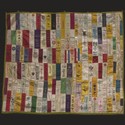Fancy Quilts (Quiltscapes)
Fancy Quilts
By the 1880s machine-manufactured bedding was widely available to average households. Women's magazines helped popularize the fancy quilt art form, encouraging women to create small decorative quilts for the parlor using fancy silk scraps and ribbons. Often commemorative and advertising ribbons were incorporated.
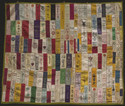
Alaska-Yukon-Pacific Exposition, c. 1909
Maker: Caroline A. MacKenzie MacKinnonBuilt on the future site of the University of Washington, the 1909 Alaska-Yukon-Pacific Exposition celebrated the West. The university today still uses the last two standing exposition buildings.... [more]
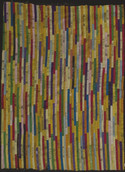
Cigar Band Top, c. 1910
Maker: Anna BrazeauWhen she married Dr. Stephen Brazeau in 1906 in Asotin, Washington, Anna Williams was 37 and raising a 12-year old daughter from a previous marriage. Encouraged by popular advertising, she fashioned a colorful home... [more]
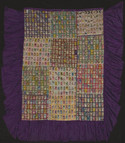
Cigarette Silks, c. 1900 -1920
Maker: UnknownAround 1900 tobacco companies created cigarettes and packaged them with silk premiums to lure women to become smokers. Advertisers suggested using these “silkies” to make “useful items for decorating the home.” Ladies at... [more]
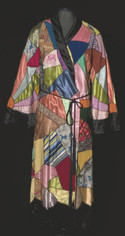
Crazy Kimono, c. 1927
Maker: Minta Taylor IrelandMinta made this kimono as a surprise 1927 graduation present for her niece Dorothy Wann of LaCrosse, Washington. Dorothy had admired one that Minta made for her own daughter, saying it was the most elegant... [more]
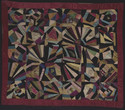
Crazy with Red Border, c. 1890
Maker: Katie GiffordKatie Gifford was an artist, who used traditional crazy patchwork to create this stunning quilt.
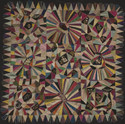
Crazy with Triangle Border, c. 1890
Maker: Katie GiffordAnother Katie Gifford graphic artwork! Magazine and popular culture encouraged women of the 1890s to fulfill themselves creatively by expressing with their hands artistic and craft projects to decorate their homes.... [more]
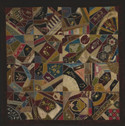
Crazy, c. 1890
Maker : Eudora Parker MeadeTrained in the skills and traditions of Souther n womanhood, 25-year-old Eudora crafted exquisite needlework. Covered with embroider y, the silk and velvet quilt also has many unique designs. Eudora came to Spokane... [more]

Crazy, c. 1920
Maker: Ida WalkerIda Walker won a 1st place blue ribbon at the 1920 Spokane Interstate Fair in the “Crazy in Silk” category. Widowed with a son to raise, Ida struggled to keep food on the table, even selling extra milk from her cow to... [more]
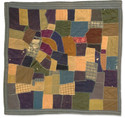
Landscape, c. 1900
Maker: UnknownHeavy with blanket filling, this utilitarian quilt was abandoned in a cellar trunk. To our modern eyes its design might evoke an aerial landscape of the region’s patchwork of farmland. But perhaps this quiltscape’s charm... [more]
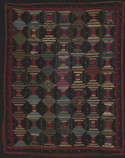
Log Cabin - Court House Steps, c. 1900
Maker: UnknownThe maker of this artistic Log Cabin variation certainly had an intuitive ability with design and color. The maker chose men’s and women’s woolen suit fabrics and necktie silks. The light colors sparkle with luminosity... [more]
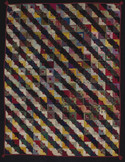
Log Cabin - Straight Furrows, c. 1890
Maker: Jeannie CreightonJeannie Creighton had plenty of time and a ready supply of silks and ribbons to hand-piece this graphic Log Cabin design. In 1890 the Creightons opened a very successful dry goods store in Moscow, Idaho, the... [more]
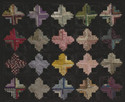
Log Cabin - Straight Set, c. 1920
Maker: Mrs. HoytMagazine advertisements and catalogs provided the home maker with “bundles” of silks and velvets for her artistic endeavors. Made for the front room, these silk quilts were advertised “to keep women’s hands busy and... [more]
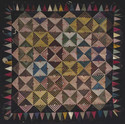
Log Cabin – Broken Dishes, c. 1890
Maker: Katie GiffordKatie displayed her artistic flare with this Log Cabin quilt made in New York as a gift for her sister’s marriage. Using narrow strips of silk set in a complicated Broken Dishes pattern, she carefully fashioned... [more]
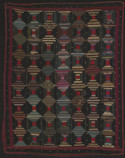
Log Cabin, Inscribed: May 15th 1881
Maker: Catherine Bush GwinAfter raising 10 children on a 200-acre farm in Washington County, Iowa, Catherine pieced this cotton Log Cabin quilt. The family moved to central Iowa in 1885, and Catherine continued to make a variety of... [more]
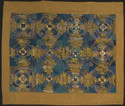
Pineapple, c. 1910 and 1939
Maker: Matilda Anderson and Johanna AndersonA single woman, working at Spokane’s Crescent Store fur department about 1910, Matilda Anderson carefully saved colorful remnants from the coat linings that she replaced. After piecing the... [more]

